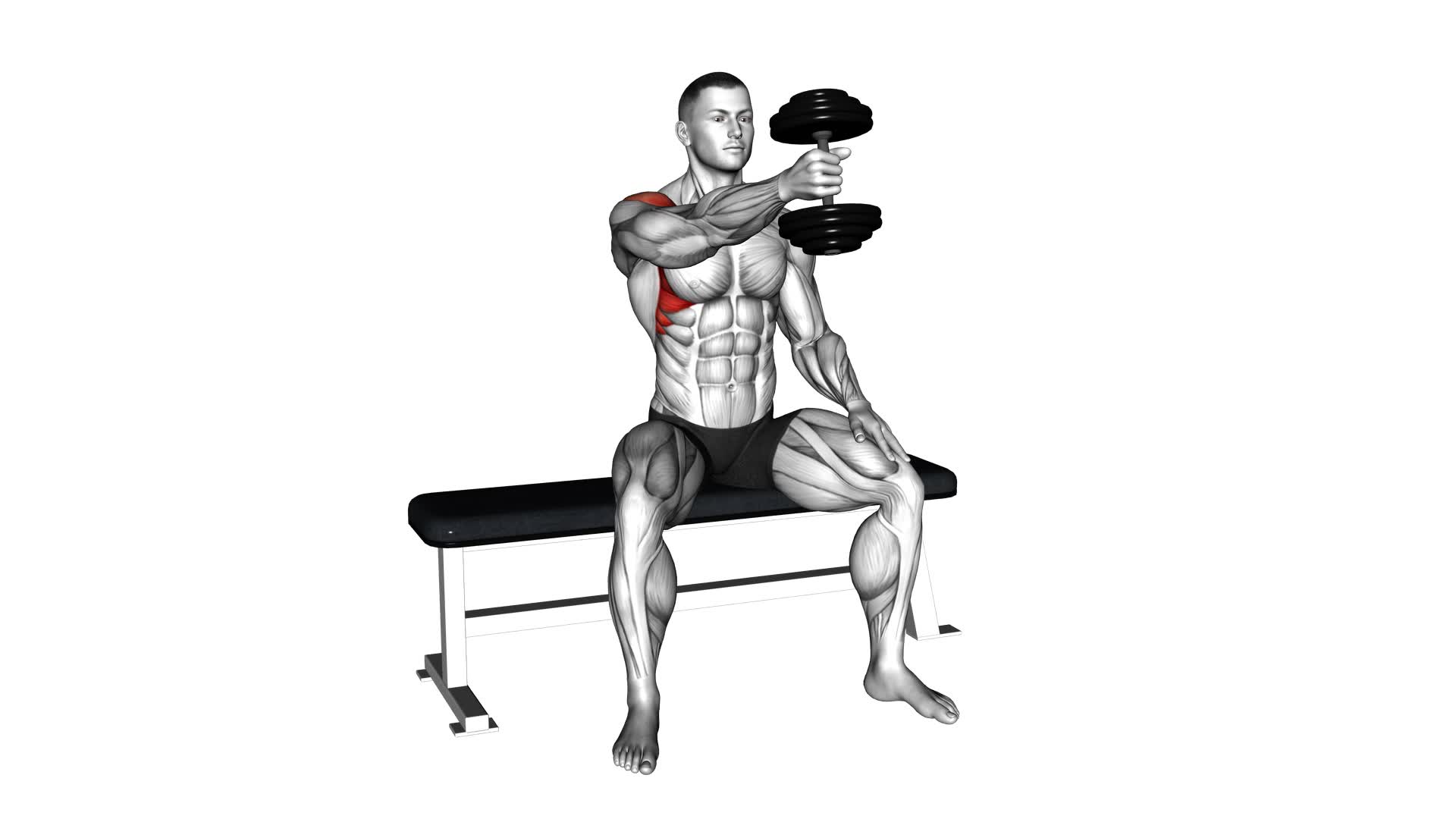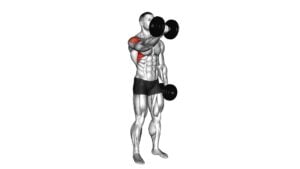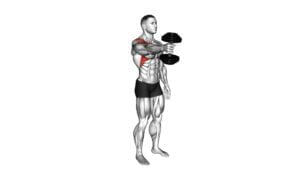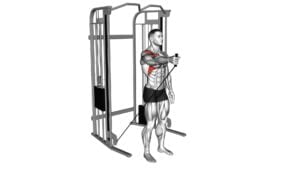Dumbbell Seated Single Arm Front Raise (male) – Video Exercise Guide & Tips

Are you looking to strengthen your shoulder muscles and improve your upper body strength?
Watch This Exercise Video
Then the Dumbbell Seated Single Arm Front Raise is the exercise for you!
In this video exercise guide, we'll show you the proper form and technique to perform this exercise effectively.
Whether you're a beginner or an advanced user, we've got variations and progressions to suit your fitness level.
Avoid common mistakes and get the most out of your workout with our helpful tips.
Let's get started!
Key Takeaways
- Targets and activates the muscles in the shoulders
- Increases shoulder stability and overall upper body strength
- Improves anterior deltoid muscle development
- Can be adapted for different fitness levels with variations and progressions
Benefits of the Dumbbell Seated Single Arm Front Raise
To maximize your upper body strength and shoulder stability, incorporate the Dumbbell Seated Single Arm Front Raise into your routine. This exercise is highly effective for targeting and activating the muscles in your shoulders, providing you with increased shoulder stability and overall upper body strength.
The Dumbbell Seated Single Arm Front Raise specifically targets your anterior deltoid, which is the front part of your shoulder. By focusing on this muscle, you can improve your shoulder stability, as well as enhance your ability to perform daily activities that require upper body strength, such as lifting and carrying objects.
During the exercise, you hold a dumbbell in one hand while seated, and then raise your arm forward until it's parallel to the ground. This movement isolates and activates your anterior deltoid, helping to strengthen and stabilize your shoulder joint.
Incorporating the Dumbbell Seated Single Arm Front Raise into your routine can help you achieve well-rounded shoulder development, improve muscle activation, and enhance your overall upper body strength. Remember to start with a weight that's appropriate for your fitness level and gradually increase as you get stronger.
Proper Form and Technique for the Exercise
To perform the Dumbbell Seated Single Arm Front Raise with proper form and technique, follow these steps.
- Start by sitting on a bench with your feet firmly planted on the ground and your back straight.
- Hold a dumbbell in one hand, resting it on your thigh, palm facing your body.
- Keep your core engaged throughout the exercise.
To initiate the movement, exhale and slowly lift the dumbbell in front of you, keeping your arm straight and your palm facing the ground.
- Stop when your arm is parallel to the ground.
- Inhale as you slowly lower the dumbbell back to the starting position, maintaining control and resisting any swinging motions.
It is important to pay attention to your form to maximize the effectiveness of the exercise and minimize the risk of injury.
- Common errors include using momentum to lift the weight, allowing the dumbbell to go too high, or arching the back.
- Remember to keep your movements controlled and steady.
The Dumbbell Seated Single Arm Front Raise targets the anterior deltoid, which is the front part of the shoulder, as well as the muscles in the upper back and arms.
- To ensure proper muscle activation, focus on engaging the shoulder muscles and avoiding excessive involvement of the neck or lower back.
Equipment and Setup for the Exercise
What equipment do you need and how should you set up for the Dumbbell Seated Single Arm Front Raise exercise?
To perform this exercise, you'll need a dumbbell and a bench or chair. Start by sitting on the bench with your feet flat on the floor, knees bent at a 90-degree angle. Hold the dumbbell in one hand, placing your elbow on the same side thigh, with your palm facing down. This is the starting position.
When selecting the proper weight for this exercise, choose a dumbbell that challenges your muscles without compromising your form. Start with a lighter weight and gradually increase as you become stronger and more comfortable with the movement. It's important to maintain proper form throughout the exercise to prevent injury and maximize results.
By positioning yourself in the dumbbell seated position and selecting the appropriate weight, you're ready to begin the Dumbbell Seated Single Arm Front Raise exercise. Remember to engage your core, keep your back straight, and raise the dumbbell in a controlled manner, focusing on using your shoulder muscles. Don't use momentum or swing the weight, as this can lead to strain or injury.
Performing this exercise with proper equipment and setup will help you target your shoulder muscles effectively and achieve optimal results.
Variations and Progressions for Advanced Users
To progress this exercise as an advanced user, you can incorporate variations that challenge your shoulder muscles in different ways. Here are some advanced modifications and alternative exercises to try:
- Alternating Single Arm Front Raise: Instead of performing the exercise with one arm at a time, alternate between left and right arms. This variation adds an element of coordination and balance to the exercise.
- Dumbbell Seated Arnold Press: Start with the dumbbells at shoulder height, palms facing you. As you raise the dumbbells, rotate your palms away from you until they face forward at the top of the movement. This variation engages additional shoulder muscles and increases the range of motion.
- Resistance Band Front Raise: Attach a resistance band to a sturdy anchor point and hold the other end with one hand. Perform the front raise movement, keeping tension on the band throughout. This alternative exercise provides a different type of resistance and challenges your shoulder muscles in a unique way.
By incorporating these advanced modifications and alternative exercises, you can continue to challenge and strengthen your shoulder muscles.
Now let's move on to the next section and learn about common mistakes to avoid.
Common Mistakes to Avoid
When performing the Dumbbell Seated Single Arm Front Raise exercise, there are common mistakes that you should avoid to ensure proper form and maximize the effectiveness of the exercise.
One common mistake is lifting the weight too high. It's important to only raise the dumbbell to shoulder level and not go any higher. Lifting the weight too high can put unnecessary strain on your shoulder joint and increase the risk of injury.
Another mistake to avoid is using momentum to lift the weight. Instead, focus on using your shoulder muscles to lift the dumbbell in a slow and controlled manner. Using momentum takes away the tension from the targeted muscles and reduces the effectiveness of the exercise.
Additionally, it's important to keep your back straight and avoid arching or rounding your spine during the exercise. This ensures proper alignment and reduces the risk of back strain.
Lastly, avoid gripping the dumbbell too tightly. A relaxed grip allows for better muscle activation and prevents unnecessary tension in your forearm and wrist.
Tips to Maximize Your Results
To maximize your results in the Dumbbell Seated Single Arm Front Raise exercise, focus on engaging your shoulder muscles and maintaining proper form throughout the movement. Here are some tips to help you get the most out of this exercise:
- Modify the exercise for different fitness levels: If you're a beginner, start with lighter weights and gradually increase the resistance as you get stronger. You can also perform the exercise while sitting on a bench with back support to provide stability. For advanced fitness levels, try using heavier weights or performing the exercise in a standing position to challenge your balance and core stability.
- Pay attention to your breathing: Proper breathing is essential during any exercise, including the Dumbbell Seated Single Arm Front Raise. Inhale as you lower the weight and exhale as you raise it, focusing on maintaining a steady and controlled breathing pattern. This not only helps you oxygenate your muscles but also promotes core engagement and stability.
Frequently Asked Questions
How Many Sets and Reps Should I Do for the Dumbbell Seated Single Arm Front Raise?
For the dumbbell seated single arm front raise, you may be wondering how many sets and reps to do. Well, it depends on your fitness level and goals. Generally, it's recommended to start with 2-3 sets of 8-12 reps per arm.
This exercise targets your shoulders and can be a great addition to your upper body workout routine. Remember to maintain proper form and technique throughout the movement.
If you're looking for alternative exercises for the front raise, try the standing or incline version.
Can I Perform This Exercise Without a Dumbbell?
Yes, you can perform the seated single arm front raise exercise without a dumbbell. There are alternative ways to perform this exercise such as using a resistance band or even just your body weight.
However, using a dumbbell offers several benefits. It provides added resistance to target and strengthen your shoulder muscles effectively. Additionally, it helps improve stability and control during the movement.
Is This Exercise Suitable for Beginners?
Yes, this exercise is suitable for beginners.
To modify for beginners, you can start with a lighter dumbbell or even no weight at all.
Focus on proper form and control throughout the movement.
Common mistakes to avoid include swinging the arm, using momentum, or lifting too heavy.
Take it slow and gradually increase weight as you get stronger.
Will the Dumbbell Seated Single Arm Front Raise Help Me Build Muscle in My Shoulders?
The dumbbell seated single arm front raise is an effective exercise for building muscle in your shoulders. By raising the dumbbell in a controlled manner, you engage the anterior deltoid muscles, leading to increased strength and definition.
This exercise also helps improve shoulder stability and posture. To vary the intensity, you can use different weights or try performing the exercise standing instead of seated.
Can I Incorporate This Exercise Into a Full-Body Workout Routine?
Yes, you can definitely incorporate the dumbbell seated single arm front raise into a full-body workout routine.
This exercise targets the front deltoids, but you can also modify it to work other muscle groups.
For example, you can try lateral raises for the side deltoids or bent over raises for the rear deltoids.
Conclusion
In conclusion, the dumbbell seated single arm front raise is a beneficial exercise for targeting the deltoid muscles.
By maintaining proper form and technique, using the right equipment and setup, and avoiding common mistakes, you can maximize your results and see improvements in your shoulder strength and stability.
Remember to progress gradually and consider advanced variations to challenge yourself further.
With dedication and consistency, you can achieve your fitness goals with this exercise.

Author
Years ago, the spark of my life’s passion ignited in my mind the moment I stepped into the local gym for the first time. The inaugural bead of perspiration, the initial endeavor, the very first surge of endorphins, and a sense of pride that washed over me post-workout marked the beginning of my deep-seated interest in strength sports, fitness, and sports nutrition. This very curiosity blossomed rapidly into a profound fascination, propelling me to earn a Master’s degree in Physical Education from the Academy of Physical Education in Krakow, followed by a Sports Manager diploma from the Jagiellonian University. My journey of growth led me to gain more specialized qualifications, such as being a certified personal trainer with a focus on sports dietetics, a lifeguard, and an instructor for wellness and corrective gymnastics. Theoretical knowledge paired seamlessly with practical experience, reinforcing my belief that the transformation of individuals under my guidance was also a reflection of my personal growth. This belief holds true even today. Each day, I strive to push the boundaries and explore new realms. These realms gently elevate me to greater heights. The unique combination of passion for my field and the continuous quest for growth fuels my drive to break new ground.







